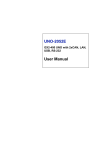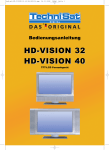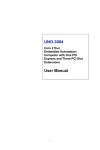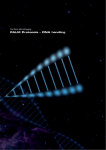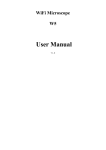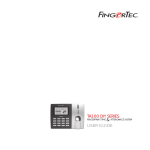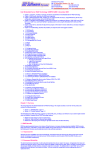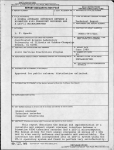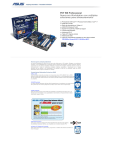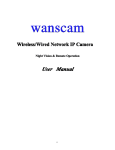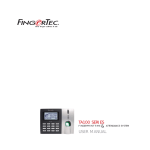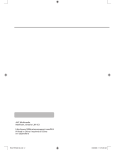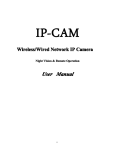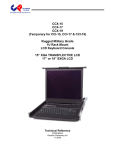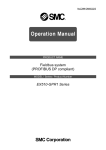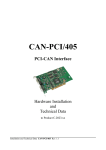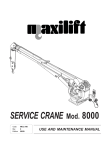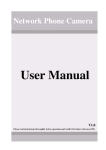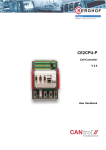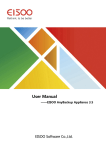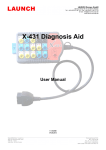Download UNO-2052 User Manual
Transcript
UNO-2052 GX1-300 UNO with 2xCAN, LAN, USB, RS-232, 8 x Isolated DI/O, 2 x AI User Manual Copyright The documentation and the software included with this product are copyrighted 2004 by Advantech Co., Ltd. All rights are reserved. Advantech Co., Ltd. reserves the right to make improvements in the products described in this manual at any time without notice. No part of this manual may be reproduced, copied, translated or transmitted in any form or by any means without the prior written permission of Advantech Co., Ltd. Information provided in this manual is intended to be accurate and reliable. However, Advantech Co., Ltd. assumes no responsibility for its use, nor for any infringements of the rights of third parties, which may result from its use. Acknowledgements IBM, PC/AT, PS/2 and VGA are trademarks of International Business Machines Corporation. Intel® and Pentium® are trademarks of Intel Corporation. Microsoft Windows and MS-DOS are registered trademarks of Microsoft Corp. C&T is a trademark of Chips and Technologies, Inc. All other product names or trademarks are properties of their respective owners. Part No. 2003205200 1st Edition Printed in Taiwan May 2004 UNO-2052 User Manual ii Product Warranty (2 years) Advantech warrants to you, the original purchaser, that each of its products will be free from defects in materials and workmanship for two years from the date of purchase. This warranty does not apply to any products which have been repaired or altered by persons other than repair personnel authorized by Advantech, or which have been subject to misuse, abuse, accident or improper installation. Advantech assumes no liability under the terms of this warranty as a consequence of such events. Because of Advantech’s high quality-control standards and rigorous testing, most of our customers never need to use our repair service. If an Advantech product is defective, it will be repaired or replaced at no charge during the warranty period. For out-of-warranty repairs, you will be billed according to the cost of replacement materials, service time and freight. Please consult your dealer for more details. If you think you have a defective product, follow these steps: 1. Collect all the information about the problem encountered. (For example, CPU speed, Advantech products used, other hardware and software used, etc.) Note anything abnormal and list any onscreen messages you get when the problem occurs. 2. Call your dealer and describe the problem. Please have your manual, product, and any helpful information readily available. 3. If your product is diagnosed as defective, obtain an RMA (return merchandize authorization) number from your dealer. This allows us to process your return more quickly. 4. Carefully pack the defective product, a fully-completed Repair and Replacement Order Card and a photocopy proof of purchase date (such as your sales receipt) in a shippable container. A product returned without proof of the purchase date is not eligible for warranty service. 5. Write the RMA number visibly on the outside of the package and ship it prepaid to your dealer. iii CE This product has passed the CE test for environmental specifications. Test conditions for passing included the equipment being operated within an industrial enclosure. In order to protect the product from being damaged by ESD (Electrostatic Discharge) and EMI leakage, we strongly recommend the use of CE-compliant industrial enclosure products. FCC Class A This equipment has been tested and found to comply with the limits for a Class A digital device, pursuant to Part 15 of the FCC Rules. These limits are designed to provide reasonable protection against harmful interference when the equipment is operated in a commercial environment. This equipment generates, uses and can radiate radio frequency energy and, if not installed and used in accordance with the instruction manual, may cause harmful interference to radio communications. Operation of this equipment in a residential area is likely to cause harmful interference in which case the user will be required to correct the interference at his own expense. Technical Support and Assistance Step 1. Visit the Advantech web site at www.advantech.com/support where you can find the latest information about the product. Step 2. Contact your distributor, sales representative, or Advantech's customer service center for technical support if you need additional assistance. Please have the following information ready before you call: - Product name and serial number - Description of your peripheral attachments - Description of your software (operating system, version, application software, etc.) - A complete description of the problem - The exact wording of any error messages UNO-2052 User Manual iv Packing List Before setting up the system, check that the items listed below are included and in good condition. If any item does not accord with the table, please contact your dealer immediately. The IPPC-9170 Series industrial panel PCs include the following models: • Plug-in 2P female screw terminal for power • Plug-in 10P female screw terminal for DI/O • Plug-in 5P female screw terminal for AI • AD509 temperature transducer • Mini jumper 2.0mm * 10 pcs • Y-type KB/MS cable • Null-modem cable (UNO-2052CE only) • DIN rail mounting kit * 2 pcs • UNO-2000 Driver & Utility CD-ROM • Advantech Warranty v UNO-2052 User Manual vi Contents Chapter 1 UNO-2052 Overview ....................................... 2 1.1Introduction .................................................................................... 1.2Hardware Specifications................................................................. 1.3Safety Precautions .......................................................................... 1.4Chassis Dimensions........................................................................ 2 2 4 5 Figure 1.1: Chassis Dimensions ..................................... 5 Chapter 2 Hardware Functionality ................................. 8 2.1UNO-2052 Peripherals ................................................................... 8 Figure 2.1:Front Panel of UNO-2052 ............................ 8 Figure 2.2:Rear Panel of UNO-2052 ............................. 9 2.2COM1: RS-232 Interface ............................................................. 2.3CAN 1~CAN 2: CAN Interface ................................................... 2.4LAN: Ethernet Connector............................................................. 2.5Power Connector .......................................................................... 2.6PS/2 Keyboard and Mouse Connector ......................................... 2.7USB Connector ............................................................................ 2.8VGA Display Connector ............................................................. 2.9RESET: Reset Button ................................................................... 2.10On-Board Isolated Digital Input ................................................. 10 10 10 10 11 11 11 12 12 Figure 2.3:Pin Assignment of Digital Input Connector 12 Table 2.1:Digital Input Connector Signal Desc. .......... 12 Figure 2.4:Isolated Digital Input Conn.- Wet Contact . 13 Figure 2.5:Isolated Digital Input Conn.- Dry Contact . 14 2.11On-Board Isolated Digital Output .............................................. 15 Figure 2.6:Pin Assignment of Isolated DO. Conn. ...... 15 Table 2.2:Signal Desc. for Digital Output Connectors 15 Figure 2.7:Isolated Digital Output Connection ............ 15 2.12On-Board Analog Input .............................................................. 16 Figure 2.8:Analog Input Connector Pin Assignment ... 16 Table 2.3:Analog Input Conn. Signal Descriptions ..... 16 Figure 2.9:Milli Volt and Volt Input ........................... 16 Figure 2.10:Thermocouple Input ................................. 17 Figure 2.11:Process Current Input ............................... 17 Chapter 3 Initial Setup.................................................... 20 3.1Inserting a CompactFlash Card .................................................... 3.2Connecting the Power................................................................... 3.3Connecting to a Hard Disk ........................................................... 3.4BIOS Setup and System Assignments.......................................... Chapter 20 20 20 21 4 I/O Command Set.......................................... 24 4.1Introduction .................................................................................. 24 4.2Syntax ........................................................................................ 24 Table 4.1:UNO-2052 Command Set Table ................. 25 4.2.1%AANNTTCCFF.................................................................... 26 vii Table of Contents Figure 4.1:Data Format for 8-bit Parameter ............... 26 4.2.2%AANNTTCCFF ..................................................................... 27 Table 4.2:Input Range Codes (Type Code) ................. 28 Table 4.3:Baud Rate Codes ......................................... 28 4.2.3$AA2 ...................................................................................... 29 4.2.4$AA2 ...................................................................................... 30 4.2.5$AAF ...................................................................................... 30 4.2.6$AAM ...................................................................................... 31 4.2.7#AA ...................................................................................... 32 4.2.8#AA ...................................................................................... 33 4.2.9#AAN ...................................................................................... 34 4.2.10$AA0 ...................................................................................... 35 4.2.11$AA1 ...................................................................................... 36 4.2.12$AAB ...................................................................................... 37 4.2.13$AA3 ...................................................................................... 38 4.2.14$AA9 ...................................................................................... 39 4.2.15$AA6 ...................................................................................... 40 4.2.16#AABB ................................................................................... 41 4.2.17#AABB ................................................................................... 42 Appendix A ......................................................................... 44 A.1Board Connectors and Jumpers ................................................... 44 Figure A.1:UNO-2052 Conn. and Jmp. Loc. (T.View) 44 Figure A.2:UNO-2052 Conn. & Jmp. Loc. (B.View) . 45 Table A.1:UNO-2052 Connectors and Jumpers .......... 46 A.2RS-232 Standard Serial Port (COM1) ......................................... 47 Table A.2:RS-232 Standard Serial Port Pin Assig. ..... 47 A.3CAN Serial Port Pin Assignment ................................................ 48 Table A.3:CAN Port Pin Assig. (CAN1~CAN2) ........ 48 A.3.1Termination Resistor Setup ..................................................... 48 A.3.2CAN Signal Wiring ................................................................. 49 Table A.4:UNO-2052 DTE Terminal DTE ................ 49 A.4Ethernet RJ-45 Connector (LAN1).............................................. 49 Table A.5:Ethernet RJ-45 Conn. Pin Assignments ...... 49 A.5Phoenix Power Connector (PWR) .............................................. 50 Table A.6:Phoenix Power Conn. Pin Assignments ..... 50 A.6PS/2 Keyboard and Mouse Connector......................................... 50 Table A.7:Keyboard and Mouse Conn. Pin Assig. ...... 50 A.7USB Connector (USB1) .............................................................. 51 Table A.8:USB Connector Pin Assignments ............... 51 A.8VGA Display Connector ............................................................. 51 Table A.9:VGA Adaptor Cable Pin Assignment ......... 51 A.9CompactFlash Master/Slave Jumper Setting (JP3) ..................... 52 MIC-3780 User Manual viii CHAPTER 1 2 UNO-2052 Overview This chapter gives background information on the UNO-2052. It shows you the UNO-2052 overview and specifications. Sections include: • Introduction • Hardware Specifications • Safety Precautions • Chassis Dimensions Chapter 1 UNO-2052 Overview 1.1 Introduction UNO-2052 is an embedded Application Ready Platform (ARP) that can shorten your development time and offer rich networking interfaces to fulfill extensive needs in different kind of projects. The Advantech Universal Network Controller (UNO-2000 series) is designed for providing services on a network enabled Application Ready Platform. Leveraging field-approved and worldwide-accepted OS technology, Advantech UNO-2000 series provides a Windows CE .NET ready solution, and supports several standard networking interfaces, such as Ethernet, Wireless LAN, RS-232/422/485 and more. Because of its openness, great expansion capability and reliable design (fanless and diskless), the Advantech UNO-2000 series are ideal embedded platforms to implement custom applications for diversified applications. 1.2 Hardware Specifications • CPU: NS Geode GX1-300 MHz, 64/128 MB SDRAM on board • VGA/Keyboard/Mouse: DB-15 VGA Connector, PS/2 keyboard & mouse • Serial Port: 1 × standard RS-232 - Speed: RS-232: 50 ~ 115.2 Kbps • USB Interface: One USB port, USB OpenHCI, Rev. 1.0 compliant • LAN: One 10/100 Base-R RJ-45 Ports • CAN: Dual isolated CAN 2.0B interfaces. - CAN controller: SJA-1000 - CAN transceiver: 82C250 - Signal support: CAN-L, CAN-H - CAN isolation: 1000 VDC • 4-ch isolated digital input: - 2,000 VDC isolation, 2,000 VDC ESD protection and 70 VDC overvoltage protection - 0 ~ 50 VDC input range - Digital input level UNO-2052 User Manual 2 • Dry Contact: Logic level 0: Close to GND Logic level 1: Open • Wet Contact: Logic level 0: +2V max Logic level 1: +4V~+50V • 4-ch isolated Digital Output: - 2,000 VDC isolation and 200 mA max / channel sink current - Keep output status after system hot reset - 5 ~ 30 VDC output range Open collector to 30 V 30 mA max. load Power dissipation: 300 mW • 2-ch Analog Input: -Input type: Thermocouple: J/K/T/E-type. -Input range: +-15 mV, +-50 mV, +-100 mV, +- 500 mV, +-1 V, +-2.5 V, +-20 mA -T/C type and temperature range: J 0 ~ 760° C K 0 ~ 1370° C T -100 ~ 400° C E 0 ~ 1000° C • SSD: One internal Type I / Type II CompactFlash card slot • HDD: HDD extension kit offered for installation of one standard 2.5'' HDD. • Watchdog Timer: Programmable. • LED: Power LED, IDE LED and one programmable diagnostic LED and buzzer. • Power Supply: 9~36 VDC • Anti-Shock: 20G@DIN IEC 68 section 2-27, half sine, 11ms 50G@Wall/Panel IEC 68 section 2-27, half sine, 11ms. • Anti-Vibration: 2G w/ CF@IEC 68 section 2-6, sine, 5~500Hz, 1 Oct./min, 1hr/axis. 1G w/ HDD@IEC 68 section 2-6, sine, 12~300Hz, 1 Oct./min, 1hr/ axis. • Operating Temperature: -10~55° C @ 5~85% related humidity. • Related Humidity: 95% @ 40° C. 3 Chapter 1 • Power Consumption: 0.6 A max under +24 V power input or 1.2 A max under +12 V power input • Power Requirement: 1 A typical under +24 V power input or 1.5 A typical under +12 V power input • Operating Temperature: -10 ~55° C (14 ~ 131° F) • Chassis Size: (WxLxH) 188.8 x 106.5 x 35.5 mm (7.5" × 4.2" × 1.4") • Weight: 0.8 kg 1.3 Safety Precautions The following sections tell how to make each connection. In most cases, you will simply need to connect a standard cable. Warning! Always disconnect the power cord from your chassis whenever you are working on it. Do not connect while the power is on. A sudden rush of power can damage sensitive electronic components. Only experienced electronics personnel should open the chassis. Caution! Always ground yourself to remove any static electric charge before touching UNO-2052. Modern electronic devices are very sensitive to static electric charges. Use a grounding wrist strap at all times. Place all electronic components on a staticdissipative surface or in a static-shielded bag. UNO-2052 User Manual 4 1.4 Chassis Dimensions Figure 1.1: Chassis Dimensions 5 Chapter 1 UNO-2052 User Manual 6 CHAPTER 2 2 Hardware Functionality This chapter shows how to set up the UNO-2052’s hardware functions, including connecting peripherals, switches and indicators. Sections include: • UNO-2052 Peripherals • COM1 RS-232 Interface • CAN1~CAN2: CAN Interface • LAN: Ethernet Connector • Power Connector • PS/2 Mouse and Keyboard Connector • USB Connector • VGA Display Connector • Reset Button • On-Board Isolated Digital Input • On-Board Isolated Digital Output • On-Board Analog Input Chapter 2 Hardware Functionality 2.1 UNO-2052 Peripherals The following two figures show the connectors on UNO-2052. The following sections give you detail information about function of each peripheral. Figure 2.1: Front Panel of UNO-2052 UNO-2052 User Manual 8 CN5 Figure 2.2: Rear Panel of UNO-2052 9 Chapter 2 2.2 COM1: RS-232 Interface The UNO-2052 offers one standard RS-232 serial communication interface port (COM1). Please refer to A.2 for the pin assignments. 2.3 CAN 1~CAN 2: CAN Interface The UNO-2052 offers two CAN serial communication interface ports. COM3 and COM4. Please refer to Appendix A.3 for the pin assignments. Control Area Network The CAN (Control Area Network) is a serial bus system specially suited for networking “intelligent” I/O devices as well as sensors and actuators within a machine or plant. Characterized by its multi-master protocol, real-time capability, error correction, high noise immunity, and the existence of many different silicon components, the CAN serial bus system, originally developed by Bosch for use in automobiles, is increasingly being used in industrial automation. For further information about CAN controllers, please refer to the data sheet of JIA-1000. 2.4 LAN: Ethernet Connector The UNO-2052 is equipped with a Realtek RTL8139C Ethernet LAN controller that is fully compliant with IEEE 802.3u 10/100Base-T CSMA/CD standards. The Ethernet port provides a standard RJ-45 jack on the board, and LED indicators on the front side shows its link (Green LED) and active (Yellow LED) status. 2.5 Power Connector The UNO-2052 comes with a Phoenix connector to provide a 9~36 VDC external power input, and features reversed wiring protection. Therefore, it will not cause any damage to the system in the case of reversed wiring of ground line and power line. UNO-2052 User Manual 10 2.6 PS/2 Keyboard and Mouse Connector The UNO-2052 provides a PS/2 keyboard and PS/2 mouse connector. A 6-pin mini-DIN connector is located on the rear panel of the UNO-2052. The UNO-2052 comes with an adapter to convert from the 6-pin miniDIN connector to two 6-pin mini-DIN connectors for PS/2 keyboard and PS/2 mouse connection. Please refer to Appendix A.5 for its pin assignments. 2.7 USB Connector The USB connector is used for connecting any device that conforms to the USB interface. Many recent digital devices conform to this standard. The USB interface supports Plug and Play, which enables you to connect or disconnect a device whenever you want, without turning off the computer. The UNO-2052 provides two connectors for USB interfaces, which gives complete Plug & Play, and hot swapping for up to 127 external devices. The USB interface complies with USB UHCI, Rev. 1.1. The USB interface can be disabled in the system BIOS setup. Please refer to Appendix A.6 for its pin assignments. 2.8 VGA Display Connector The UNO-2052 provides a VGA controller (Chipset: VIA Twister chip with Integrated S3 Savage4 2D/3D/Video accelerator) for a high resolution VGA interface. It supports VGA and VESA, up to 1280 x 1024 @ 8 bpp and 1024 x 768 @ 16bpp resolution, and up to 32 MB shared memory. The VGA interface is reserved for system testing and debugging. The UNO-2052's JP8 is a 6-pin mini connector and CN7 is a 15-pin connector for a VGA monitor. A VGA cable is attached to convert from a 6-pin mini connector to a standard VGA connector. You can choose one of the VGA interfaces for system testing and debugging. Pin assignments for VGA display are described in Appendix A.7. 11 Chapter 2 2.9 RESET: Reset Button Press the "Reset" button to activate a reset function. 2.10 On-Board Isolated Digital Input The UNO-2052 has four isolated digital input channels designated DI0~DI3. Pin Assignment The connector type of UNO-2052 is a plug-in screw terminal block that enables you to connect to field I/O devices directly without additional accessories. Figure 2-3 and Table 2-1 shows its pin assignment as well as signal descriptions. DI0 DI1 DI2 DI3 COM IsolatedDI Figure 2.3: Pin Assignment of Digital Input Connector Table 2.1: Digital Input Connector Signal Descriptions Signal Name Reference Direction Description DI <0…3> COM Input Isolated digital input signals COM - Input Common ground UNO-2052 User Manual 12 Isolated Inputs Each of the isolated digital input channels accepts 10 ~ 50 VDC inputs, and bi-directional inputs. It means that you can apply positive or negative voltage to an isolated input pin (Vin). All four channels share one common pin (COM). Figure 2.4 shows how to connect an external input source to one of the UNO-2052’s isolated input channels. VCC 2K DI 0~+50V DC COM Digital GND Digital GND Figure 2.4: Isolated Digital Input Connection- Wet Contact 13 Chapter 2 VCC 2K DI COM Digital GND Figure 2.5: Isolated Digital Input Connection- Dry Contact UNO-2052 User Manual 14 2.11 On-Board Isolated Digital Output The UNO-2052 has four isolated digital output channels designated DO0~DO3. Pin Assignment The connector type of UNO-2052 is a plug-in screw terminal block that enables you to connect to field I/O devices directly without additional accessories. Figure 2-6 and Table 2-2 shows its pin assignment as well as signal description. DO0 DO1 DO2 DO3 COM IsolatedDO Figure 2.6: Pin Assignment of Isolated Digital Output Connector Table 2.2: Signal Descriptions for Digital Output Connectors Signal Name Reference Direction Description DO <0…3> COM Output Isolated digital output signals COM - Input Common ground +Vs DO R2 + SSR - AC COM Digital GND Digital GND Open Collector Figure 2.7: Isolated Digital Output Connection 15 Chapter 2 2.12 On-Board Analog Input The UNO-2052 has two analog input channels designated AI0, AI1. Pin Assignment The connector type of UNO-2052 is plug-in screw terminal block that enables you to connect to field I/O devices directly without additional accessories. Figure 2-8 and Table 2-3 shows its pin assignment as well as signal description. AI0+ AI0- AI1+ AI1- CJC.1 CJC.2 AI Figure 2.8: Analog Input Connector Pin Assignment Table 2.3: Analog Input Connector Signal Descriptions Signal Name Direction Description AI <0,1> Input CJC <1,2> Analog input signals CJC sensor for calibration AI+ Hi + V mV/V - AI- Lo Figure 2.9: Milli Volt and Volt Input UNO-2052 User Manual 16 AI+ Hi + 120 ohm Iin 0~20mA JP5/JP6 - AI- Lo Figure 2.10: Thermocouple Input AI+ T/ C AI- Figure 2.11: Process Current Input Jumper Description JP5 Closed, process current input for AI0 Open, volt or thermocouple input for AI0 JP6 Closed, process current input for AI1 Open, volt or thermocouple input for AI1 17 Chapter 2 UNO-2052 User Manual 18 CHAPTER 3 2 Initial Setup This chapter provides information on how to setup UNO-2052. Sections include: • Inserting a CompactFlash Card • Connecting the Power • Connecting to a Hard Disk • BIOS Setup and System Assignments Chapter 3 Initial Setup 3.1 Inserting a CompactFlash Card The procedure for installing a CompactFlash card into the UNO-2052 is as follows, please follows these steps carefully. Step 1: Remove the power cord. Step 2: Unscrew the four screws from the rear panel of the UNO-2052. Step 3: Remove the rear panel. Step 4: Plug a CompactFlash card with the user’s OS and application program into a CompactFlash card slot on the board. Step 5: Screw back the rear panel with the four screws. 3.2 Connecting the Power Connect the UNO-2052 to a 9~36 VDC power source. The power source can either be from a power adapter or an in-house power source. 3.3 Connecting to a Hard Disk The procedure for installing a hard disk into the UNO-2052 is as follows, please follows these steps carefully. Step 1: Remove the power cord. Step 2: Unscrew the four screws from the rear panel of the UNO-2052. Step 3: Remove the rear panel. Step 4: Connect an IDE flat cable to the primary (recommended) or secondary IDE connector, then connect the other side of the connector to the hard disk. Step 5: Screw back the rear panel with the four screws. UNO-2052 User Manual 20 3.4 BIOS Setup and System Assignments UNO-2052 uses the Advantech SOM-2353 CPU module. Further information about the SOM-2353 CPU module can be found in the SOM-2353 user manual. Please note that you can try to “LOAD BIOS DEFAULTS” from the BIOS Setup manual if the UNO-2052 does not work properly. 21 Chapter 3 UNO-2052 User Manual 22 4 CHAPTER 2 I/O Command Set This chapter introduces the command sets used for digital input, digital output and analog input with UNO-2052. Chapter 4 I/O Command Set 4.1 Introduction To avoid communication conflicts when several devices try to send data at the same time, all actions are instigated by the UNO-2052. The basic form is a command/response protocol with the UNO-2052 initiating the sequence. When UNO-2052 is not transmitting, other devices are in listening mode. All of UNO-2052’s command sets follow the Advantech ADAM command set format. 4.2 Syntax The syntax of the Advantech ADAM command set is listed as below: [delimiter character] [address*] [command] [data] [checksum**] [carriage return] Every command begins with a delimiting character, which are defined below: $: dollar sign #: pound sign %: percentage sign @: at sign The delimiter character is followed by a two-character address (hexadecimal) that specifies the UNO-2052. The I/O address of UNO-2052 is defined as (0x01)H. The actual two character command follows the address. Depending on the command, an optional data segment follows the command string. An optional two character checksum may be appended to the total string; but the checksum is disabled in UNO-2052. Every command is terminated by a carriage return (cr). * The I/O address of UNO-2052 is defined as (0x01)H. ** The checksum is disabled in UNO-2052 UNO-2052 provides an internal serial communication port (COM2). You can configure the digital input, digital output and analog input function of UNO-2052 by COM2. The baud rate of COM2 can support 115200 bps, 57600 bps, 38400 bps, 19200 bps and 9600 bps. UNO-2052 User Manual 24 Table 4.1: UNO-2052 Command Set Table Command Syntax Command Name Description %AANNTTCCFF Configuration Sets input range, integration time for a specified analog input module $AA2 Configuration Status Returns the configuration parameters for the specified analog input module $AAF Read Firmware Version Returns the firmware version source code from the specified analog input module $AAM Read Module Name Returns the module name from the specified analog input module #AA Analog Data In Returns the input value from a specified analog input module in the currently configured data format #AAN Read Analog Input from Channel N Returns the input value from channel number n of the specified analog input module $AA0 Span Calibration Calibrate the analog input module to correct for gain errors $AA1 Offset Calibration Calibrate the analog input module to correct for offset errors $AAB Open Thermocouple Detection Ask the module to respond whether the thermocouple is open or closed. $AA3 CJC Status Returns the value of the CJC sensor for a specified analog input module $AA9 CJC Offset Calibration Calibrates the CJC sensor for offset errors $AA6 Digital Data In Returns the values of digital I/O channels of the addressed module #AABB(data) Digital Data Out Write specified values to either a single channel or all channels simultaneously 25 Chapter 4 4.2.1 %AANNTTCCFF Name: Configuration Description: Sets address, input range, baud rate, data format, checksum status, and/or integration time for an analog input module. Syntax: %AANNTTCCFF(cr) % is a delimiter character. AA(01) represents the 2-character hexadecimal address of the analog input module you want to configure. NN represents the new hexadecimal address of the analog input module. The address of UNO-2052 must be 01h. TT represents the type (input range) code. CC represents the baud rate code. FF is a hexadecimal number that equals the 8-bit parameter representing the data format, checksum status and integration time. The layout of the 8-bit parameter is shown in figure 4-1. Bits 2 through 5 are not used and are set to 0. (cr) is the terminating character, carriage return (0Dh) 7 6 5 Checksum status 0: Disabled 1: Enabled 4 3 2 1 Not used 0 DataFormat 00: Engineering Unit Integrationtime 0: 50 ms (Operation under 60 MHz power) 1: 60 ms (Operation under 50 MHz power) Figure 4.1: Data Format for 8-bit Parameter UNO-2052 User Manual 26 4.2.2 %AANNTTCCFF Response: !AA(cr) if the command is valid. ?AA(cr) if an invalid parameter was entered or if the INIT* terminal was not grounded when attempting to change baud rate or checksum settings. There is no response if the module detects a syntax error or communication error or if the specified address does not exist. ! delimiter character indicates a valid command was received. ? delimiter character indicates the command was invalid AA (01) represents the 2-character hexadecimal address of an analog input module. (cr) is the terminating character, carriage return (0Dh) Example: command: %0101050600(cr) response: !01(cr) The UNO-2052 module with address 01h is configured to: input range ±2.5 V, baud rate 9600, integration time 50 ms (60 Hz), engineering units data format and no checksum checking or generation. The response indicates that the command was received. Wait 1 second to let the new configuration settings take effect before issuing a new command to the module. NOTICE: An analog input module requires a maximum of 1 second to perform auto calibration and ranging after it is reconfigured. During this time span, the module cannot be addressed to perform any other actions. 27 Chapter 4 Table 4.2: Input Range Codes (Type Code) Input Range Code (Hex) Input Range for 4011,4011D,4018,4018+,4018M 00 ± 15 mV 01 ± 50 mV 02 ± 100 mV 03 ± 500 mV 04 ±1V 05 ± 2.5 V 06 ± 20 mA 0E Type J Thermocouple 0 to 760° C 0F Type K Thermocouple 0 to 1370° C 10 Type T Thermocouple -100 to 400° C 11 Type E Thermocouple 0 to 1370° C Table 4.3: Baud Rate Codes Baud Rate Code (hex) Baud Rate 06 9600 bps 07 19.2 kbps 08 38.4 kbps 09 57.6 kbps 0A 115.2Kbps UNO-2052 User Manual 28 4.2.3 $AA2 Name: Configuration Status Description: The command requests the return of the configuration data from the analog input module at address AA. Syntax: $AA2(cr) $ is a delimiter character. AA (01) represents the 2-character hexadecimal address of the analog input module that you want to interrogate. 2 is the Configuration Status command. (cr) is the terminating character, carriage return (0Dh). Response: !AATTCCFF(cr) if the command is valid. ?AA(cr) if an invalid operation was entered. There is no response if the module detects a syntax error or communication error or if the specified address does not exist. ! delimiter character indicates a valid command was received. ? delimiter character indicates the command was invalid. AA (01) represents the 2-character hexadecimal address of an analog input module. TT represents the type code. Type code determines the input range. CC represents the baud rate code. FF is a hexadecimal number that equals the 8-bit parameter that represents the data format, checksum status and integration time . The layout of the 8-bit parameter is shown in figure 4-1. Bits 2 to 5 are not used, and are set to 0. (cr) is the terminating character, carriage return (0Dh). (Also see the %AANNTTCCFF configuration command) 29 Chapter 4 4.2.4 $AA2 Example: command: $012(cr) response: !01050600(cr) The command asks the analog input module at address (01)H to send its configuration data. The analog input module at address (01)H responds with an input range of 2.5 volts, a baud rate of 9600 bps, an integration time of 50 ms (60 Hz), engineering units are the currently configured data format, and no checksum function or checksum generation. 4.2.5 $AAF Name: Read Firmware Version Description: The command requests the analog input module at address AA to return the version code of its firmware Syntax: $AAF (cr) $ is a delimiter character. AA (01) represents the 2-character hexadecimal address of the analog input module that you want to interrogate. F identifies the version command. (cr) is the terminating character, carriage return (ODh) Response: !AA(Version)(cr) if the command is valid. There is no response if the module detects a syntax error or communication error, or if the specified address does not exist. ! is a delimiter character indicating a valid command was received. AA (01) represents the 2-character hexadecimal address of an analog input module. (Version) is the version code of the module’s firmware at address AA. (cr) is the terminating character, carriage return (ODh). UNO-2052 User Manual 30 4.2.6 $AAM Name Read Module Name Description: The command requests the analog input module at address AA to return its name Syntax: $AAM (cr) $ is a delimiter character. AA (01) represents the 2-character hexadecimal address of the analog input module that you want to interrogate. M is the Read Module Name command. (cr) is the terminating character, carriage return (ODh) Response: !AA(Module Name)(cr) if the command is valid. There is no response if the module detects a syntax error or communication error, or if the specified address does not exist. ! is a delimiter character indicating a valid command was received. AA (01) represents the 2-character hexadecimal address of an analog input module. (Module Name) is the name of the module at address AA. (cr) is the terminating character, carriage return (ODh). 31 Chapter 4 4.2.7 #AA NameAnalog Data In Description: The command will return the input value from a specified (AA) module in the currently configured data format. Syntax: #AA(cr) # is a delimiter character. AA (01) represents the 2-character hexadecimal address of an analog input module. (cr) is the terminating character, carriage return (0Dh). Response: >(data)(cr) There is no response if the module detects a syntax error or communication error or if the specified address does not exist. > is a delimiter character. (data) is the input value in the configured data format of the interrogated module. (For data formats, see Appendix B). (cr) is the terminating character, carriage return (0Dh). Example: command:#01(cr) response:+1.8222+1.8220(cr) The command interrogates the analog input module at address 01h for its input values of all channels. The analog input module responds with channels from 0 to 1 with +1.8222 volts and +1.8220 volts. UNO-2052 User Manual 32 4.2.8 #AA NOTICE: When modules measure Thermocouple or RTD input values that are outside their configured range, they will send data that implies input out of bounds. The next table shows the values that the modules will return, depending on the configured data format and if the input value falls under or exceeds the configured range. Only when modules are configured for Thermocouple will this “input out of bounds” warning occur. When analog input modules measure voltage or current that falls outside the configured range, they will return the actual measured input! In the next example the target module is configured for an input range of T/C type J (Input range: 0 - 760° C) and for a data format in engineering units. The module measures an input value of 820° C. Example: command: #01(cr) response: >+9999(cr) By returning a high value, +9999, the module at address 01h indicates that the measured input value exceeds the configured range. 33 Chapter 4 4.2.9 #AAN Name: Read Analog Input from Channel N Description: The command will return the input value from one of the eight channels of a specified (AA) module in the currently configured data format. Syntax: #AAN(cr) # is a delimiter character. AA (01) represents the 2-character hexadecimal address of the analog input module. N identifies the channel you want to read. The value can range from 0 to 1 for UNO-2052. (cr) is the terminating character, carriage return (0Dh). Response: >(data)(cr) There is no response if the module detects a syntax error or communication error or if the specified address does not exist. > is a delimiter character. (data) is the input value of the channel number N. Data consists of a + or - sign followed by five decimal digits with a fixed decimal point. (cr) is the terminating character, carriage return (0Dh). Example: command: #010(cr) response: >+1.4567(cr) The command requests the analog input module at address 01h to return the input value of channel 0. The analog input module responds that the input value of channel 0 is equal to +1.4567 volts. UNO-2052 User Manual 34 4.2.10 $AA0 Name: Span Calibration Description: Calibrates an analog input module to correct for gain errors. Syntax: $AA0(cr) $ is a delimiter character. AA (01) represents the 2-character hexadecimal address of the analog input module which is to be calibrated. 0 represents the span calibration command. (cr) is the terminating character, carriage return (0Dh). Response: !AA(cr) if the command was valid. ?AA(cr) if an invalid operation was entered. There is no response if the module detects a syntax error or communication error or if the specified address does not exist. ! delimiter character indicates a valid command was received. ? delimiter character indicates the command was invalid. AA (01) represents the 2-character hexadecimal address of the analog input module. (cr) represents terminating character, carriage return (0Dh). In order to successfully calibrate an analog input module’s input range, a proper calibration input signal should be connected to the analog input module (channel 0 and 1) before and during the calibration. NOTICE: An analog input module requires a maximum of 1 second to perform auto calibration and ranging after it received a Span Calibration command. During this interval, the module cannot be addressed to perform any other actions. 35 Chapter 4 4.2.11 $AA1 Name: Offset Calibration. Description: Calibrates an analog input module to correct for offset errors. Syntax: $AA1(cr) $ is a delimiter character. AA (01) represents the 2-character hexadecimal address of the analog input module you want to calibrate. 1 represents the offset calibration command. (cr) is the terminating character, carriage return (0Dh). Response: !AA(cr) if the command is valid. ?AA(cr) if an invalid operation was entered. There is no response if the module detects a syntax error or communication error or if the specified address does not exist. ! delimiter character indicates a valid command was received. ? delimiter character indicates the command was invalid. AA (01) represents the 2-character hexadecimal address of the analog input module. (cr) represents terminating character, carriage return (0Dh). In order to successfully calibrate an analog input module’s input range, a proper calibration input signal should be connected to the analog input module (channel 0 and 1) before and during the calibration. NOTICE: An analog input module requires a maximum of 1 second to perform auto calibration and ranging after it received an Offset Calibration command . During this interval, the module can not be addressed to perform any other actions. UNO-2052 User Manual 36 4.2.12 $AAB Name: Open Thermocouple Detection Description: Asks the module to respond whether the thermocouple is open or not. Syntax: $AAB(cr) $ is a delimiter character AA (01) represents the 2-character hexadecimal address of the analog input module to be detected. B is the channel diagnose command. (cr) is the terminating character, carriage return (0Dh) Response: !AANN(cr) if the command is valid. ?AA(cr) if an invalid command was issued. There is no response if the module detects a syntax error or communication error of if the specified address does not exist. ! delimiter character indicates a valid command was received. ? delimiter character indicates the command was invalid. AA (01) represents the 2-character hexadecimal address of the analog input module. NN (range 00-03) is a hexadecimal number that equals the 8-bit parameter, representing the status of analog input channels. Bit value 0 means normal status; and bit value 1 means channel open wiring. (cr) is the terminating character, carriage return (0Dh) 37 Chapter 4 4.2.13 $AA3 Name: CJC Status command Description: Instructs the addressed analog input module to read its CJC (Cold Junction Compensation) sensors and return the acquired data. Syntax: $AA3(cr) $ is a delimiter character. AA (01) represents the 2-character hexadecimal address of the analog input module which contains the CJC Status you wish to retrieve. 3 is CJC Status command. (cr) is the terminating character, carriage return (0Dh). Response: >data(cr) if the command is valid. ?AA(cr) if an invalid command was issued. There is no response if the module detects a syntax error or communication error or if the specified address does not exist. ! delimiter character indicates a valid command was received. ? delimiter character indicates the command was invalid AA (01) represents the 2-character hexadecimal address of an analog input module. (data) is the value that is retrieved by the module by reading its CJC sensor. The data format, in degrees Celsius, consists an “+” or “-” sign followed by five decimal digits and a fixed decimal point. The resolution of the data is 0.1° C. (cr) is the terminating character, carriage return (0Dh). Example: command: $013(cr) response: >+0036.8(cr) The command request the analog input module at address 01h to read its CJC sensor and return the data. The analog input module at address 01h responds with: 36.8° C. UNO-2052 User Manual 38 4.2.14 $AA9 Name: CJC Offset Calibration Description: Calibrates an analog input module to adjust for offset errors of its CJC (Cold Junction Compensation) sensors. Syntax: $AA9S(number of counts)(cr). $ is a delimiter character. AA (01) represents the 2-character hexadecimal address of the analog input module which contains the CJC Status you wish to retrieve. 9 is CJC Status command. S sign, + or -, indicates whether to increase or decrease the CJC offset value. (number of counts) a four character hexadecimal “count” value. Each count equals approximately 0.009° C. The value can range from 0000 to FFFF. (cr) is the terminating character, carriage return (0Dh). Response: !AA(cr) if the command is valid. ?AA(cr) if an invalid command was issued. There is no response if the module detects a syntax error or communication error or if the specified address does not exist. ! delimiter character indicates a valid command was received. ? delimiter character indicates the command was invalid. AA (01) represents the 2-character hexadecimal address of an analog input module. (cr) is the terminating character, carriage return (0Dh). Example: command: $019+0042(cr) response: !01(cr) The command increases the CJC offset value of the analog input module at address 01h with 66 counts (42 hex) which equals about 0.6° C. NOTICE: An analog input module requires a maximum of 2 seconds to perform auto calibration and ranging after it received an CJC Calibration command . During this interval, the module can not be addressed to perform any other actions. 39 Chapter 4 4.2.15 $AA6 Name: Digital Data In Description: This command requests that the specified (AA) module returns the status of its digital input channels and returns a readback value of its digital output channels. Syntax: $AA6(cr) $ is a delimiter character. AA (01) represents the 2-character hexadecimal address of the digital I/O module. 6 is the Digital Data In command. (cr) is the terminating character, carriage return (0Dh). Response: !(dataOutput)(dataInput)00(cr) if the command was valid. ?AA(cr) if an invalid command has been issued. There is no response if the module detects a syntax error or communication error or if the specified address does not exists. ! delimiter character indicating a valid command was received. ? delimiter character indicating the command was invalid. AA (01) represents the 2-character hexadecimal address of the digital I/O module that is responding. (dataOutput) two-character hexadecimal value which either is the readback of a digital output channel or a relay. (dataInput) two-character hexadecimal value representing the input values of the digital I/O module. (cr) is the terminating character, carriage return (0Dh). Example: command: $016(cr) response: !090300(cr) The first two characters of the response, value 09h (00001001), indicate that digital output channels 0 and 3 are ON, channels 1, 2, are OFF. The second two characters of the response, value 03h (00000010), indicate that digital input channels 0 and 1 are HIGH, channels 2, 3 are LOW. UNO-2052 User Manual 40 4.2.16 #AABB Name: Digital Data Out Description: The command either sets a single digital output channel or sets all digital output channels simultaneously. Syntax: #AABB(data)(cr) # is a delimiter character. AA (01) represents the 2-character hexadecimal address of the digital I/O module you want to set its output value. BB is used to indicate whether all channels will be set or a single channel will be set. In the last case BB also indicates which channel. Writing to all channels (write a byte): both characters should be equal to zero (BB=00). Writing to a single channel (write a bit): First character is 1, second character indicates channel number which can range from 0 to 3. (data) is the hexadecimal representation of the digital output value(s). When writing to a single channel (bit) the first character is always 0. The value of the second character is either 0 or 1. When writing to all channels (byte), both characters are significant (range 00h-0Fh). The digital equivalent of these two hexadecimal characters represent the channels values. 41 Chapter 4 4.2.17 #AABB Response: >(cr) if the command was valid. ?AA(cr) if an invalid command has been issued. There is no response if the module detects a syntax error or communication error or if the specified address does not exists. > delimiter character indicating valid command was received. ? delimiter character indicating the command was invalid. AA (01) represents the 2-character hexadecimal address of the digital I/O module that is responding. (cr) is the terminating character, carriage return (0Dh). Examples: command: #010005(cr) response: >(cr) An output byte with value 05h (00000101) is sent to the digital I/O module at address (01)H. Its channels 0 and 2 will be set to ON. Other channels are set to OFF. command: #011201(cr) response: >(cr) An output bit with value 1 is sent to channel 2 of a digital I/O module at address 01h. Channel two of the digital I/O module is set to ON. UNO-2052 User Manual 42 APPENDIX A 2 System Settings This chapter provides information on the system settings of UNO-2052. Sections include: • Board Connectors and Jumpers • RS-232 Standard Serial Port • CAN Serial Port • Ethernet RJ-45 Connector • Phoenix Power Connector (PWR) • PS/2 Keyboard and Mouse Connector • USB Connector • VGA Display Connector • CompactFlash Master/Slave Jumper Setting Appendix A A.1 Board Connectors and Jumpers There are connectors and jumpers on the UNO-2052 board. The following sections tell you how to configure the UNO-2052 hardware setting. Figure A-1 and figure A-2 show the locations of UNO2052 connectors and jumpers. Figure A.1: UNO-2052 Connector and Jumper Location (Top View) UNO-2052 User’s Manual 44 CN5 Figure A.2: UNO-2052 Connector and Jumper Location (Bottom View) 45 Appendix A Table A.1: UNO-2052 Connectors and Jumpers CON1 COM1 standard RS-232 port P1 CAN 1 DB-9 connector P2 CAN 2 DB-9 connector JP3 CompactFlash IDE Primary Master/Slave jumper JP4 Isolated digital input and digital output connector JP5 Analog input connector JP12 Termination resistor for CAN 1 and CAN 2 Power Phoenix power connector CN4 Internal CompactFlash card slot DB5 Power IDE LED DB6 Power LED DB7 Diagnostic LED KM1 PS2 keyboard and mouse connector CON1 USB connector LAN1 Ethernet RJ-45 connector VGA1 VGA DB-15 connector J1 Reset button UNO-2052 User’s Manual 46 A.2 RS-232 Standard Serial Port (COM1) 1 2 3 4 5 6 7 8 9 Table A.2: RS-232 Standard Serial Port Pin Assignments Pin RS-232 Signal Name 1 DCD 2 RxD 3 TxD 4 DTR 5 GND 6 DSR 7 RTS 8 CTS 9 RI 47 Appendix A A.3 CAN Serial Port Pin Assignment Table A.3: CAN Port Pin Assignments (CAN1~CAN2) Pin CAN Signal Name 1 N/A 2 CAN-L 3 GND 4 N/A 5 N/A 6 N/A 7 CAN-H 8 N/A 9 N/A 1 CAN-L 2 GND 3 4 5 6 7 CAN-H 8 9 A.3.1 Termination Resistor Setup Terminal resistors are factory installed to allow for impedance matching. These resistors can be enabled by utilizing JP12 (shown below). The value of the resistor should equal the characteristic impedance of the signal wires (approximately 120 ohms). The following figure shows resistor placements. Enable Termination Resistor for CAN1 Port JP12 Enable Termination Resistor for CAN2 Port JP12 UNO-2052 User’s Manual 48 A.3.2 CAN Signal Wiring The CAN standard supports half-duplex communication. This means that just two wires are used to transmit and receive data. D.T.E CANTransceiver CAN-H D.T.E CANTransceiver CAN-L CAN-H D.T.E CANTransceiver CAN-L CAN-H CAN-L 120 ohms 120 ohms Wiring connections are as follows: Table A.4: UNO-2052 DTE (male=DB-9) Terminal DTE Pin Signal Signal 7 CAN-H CAN-H 3 GND GND 2 CAN-L CAN-L A.4 Ethernet RJ-45 Connector (LAN1) Table A.5: Ethernet RJ-45 Connector Pin Assignments Pin 10/100Base-T Signal Name 1 XMT+ 2 XMT- 3 RCV+ 4 NC 5 NC 6 RCV- 7 NC 8 NC 49 Appendix A A.5 Phoenix Power Connector (PWR) Table A.6: Phoenix Power Connector Pin Assignments Pin Signal Name 1 +9~36 VDC 2 GND A.6 PS/2 Keyboard and Mouse Connector 6 5 4 3 2 1 Table A.7: Keyboard and Mouse Connector Pin Assignments Pin Signal Name 1 KB DATA 2 MS DATA 3 GND 4 VCC 5 KB Clock 6 MS Clock UNO-2052 User’s Manual 50 A.7 USB Connector (USB1) Table A.8: USB Connector Pin Assignments Pin Signal Name Cable Color 1 VCC Red 2 DATA+ White 3 DATA- Green 4 GND Black A.8 VGA Display Connector 5 1 10 6 15 11 Table A.9: VGA Adaptor Cable Pin Assignment Pin Signal Name Pin 1 Red 9 NC 2 Green 10 GND 3 Blue 11 NC 4 NC 12 NC 5 GND 13 H-SYNC 6 GND 14 V-SYNC 7 GND 15 NC 8 GND 51 Signal Name Appendix A A.9 CompactFlash Master/Slave Jumper Setting (JP3) The CompactFlash interface uses a primary IDE channel, which could be set as the master or slave device by changing the setting of JP3. Master Device (Default): JP3 Closed Slave Device: JP3 Open UNO-2052 has one internal CompactFlash card slot and one external CompactFlash card slot. Internal CompactFlash card slot supports CompactFlash type I (3mm thick) only and External CompactFlash card slot supports both Type I and type II (5mm thick) cards. UNO-2052 User’s Manual 52




























































